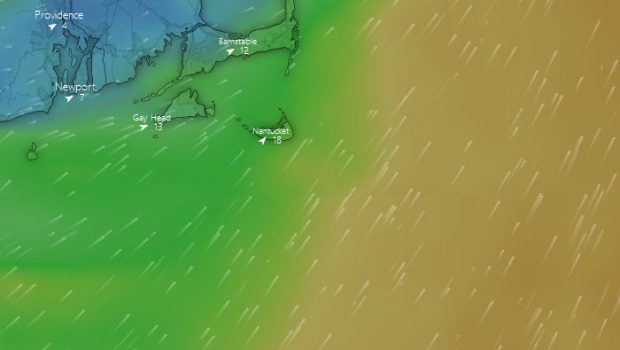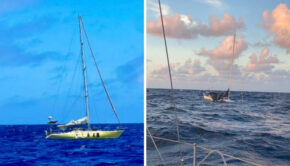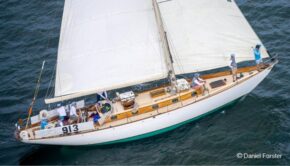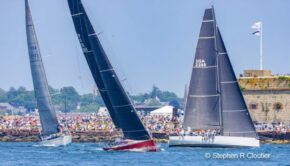Thrash to begin Newport Bermuda Race
Published on June 16th, 2022
With a forecast that looks fresh to frightening for at least the first 36 to 48 hours of the race, a fleet of 187 sailing yachts is set to take on the challenge of the 2022 Newport Bermuda Race on June 17 beginning at 1310 hours.
The pre-race forecast is predicting southwesterly winds between 17 and 22 knots at the start and lasting into the evening, with waves possibly 8 to 10 feet offshore. A cold front is predicted to pass over the fleet on the first night, bringing with it squalls and strong winds.
After the front, the winds are predicted to shift to a northwesterly quadrant and remain in the 20s, with higher gusts. In sum, it’s all lining up for a “proper” Newport Bermuda Race in the ocean.
Record Run a Possibility
The record within the major divisions—St. David’s Lighthouse (limits on pro crew) and Gibbs Hill Lighthouse (no limits)—is 39 hours and 39 minutes, set by George David’s maxi yacht Rambler 90 in 2012, an average speed of 16 knots.
The course record in the Open Division is 34 hours and 42 minutes (18.3-knot average speed), set by the 100-foot maxi yacht Comanche, skippered by North Sails President Ken Read, in 2016. (Open Division yachts are not eligible for the overall race prizes.)
This year’s fleet includes two multihulls that are capable of some fast speeds, including Jason Carroll’s (New York City) MOD70 Argo and the 80-foot VPLP trimaran Ultim’emotion2, owned by Antoine Rabaste (Nimes, France) and skippered by Jacek Siwek (Overijse, Belgium).
In the 2018 Bermuda Race, the first time that multihulls were entered, Carroll and crew sailed the Gunboat 62 Elvis to line honors in 63 hours. Carroll then upgraded to the foil-assisted trimaran Argo and has proceeded to set seven race or world records. The Newport Bermuda Race multihull record could well be next.
“It looks like a rough race, but fast for us,” said 50-year-old Chad Corning (New Rochelle, New York), crew and manager of the program. “We should have a pre-frontal gusty breeze the whole time.
“Our elapsed time looks like 28 hours on the Global Forecast System and 26 hours on the European model. The hi-res model (HRR) is just coming into focus, but they all seem fairly consistent. We’ll have to balance prudence and speed, so we’ll probably be sailing at 92 percent of polars.”
The notable, single entry in the Open Division is Mālama, the new foil-assisted IMOCA 60 campaigned by 11th Hour Racing and skipper Charlie Enright (Barrington, Rhode Island) for next year’s The Ocean Race, beginning from Spain in January, 2023. Could Mālama outrun Comanche’s Open Division mark?
“Yes, it’s definitely attainable, but it’s never quite that simple,” said the 37-year-old Enright, who’s gearing up for his third race around the world. “A lot of it depends on the timing of the front, and the biggest variable is the sea state. I feel like we go 30 knots every time we leave the dock. We’ve reached a max of 38 knots, but record-breaking is more about high sustained average speeds.”
A Race of Challenges
Since its inception in 1906, the Bermuda Race has presented different sorts of challenges, including navigation, seamanship, and personal limits. Navigation plays a huge part as the fleet crosses the Gulf Stream, the warm, northeasterly-flowing ocean current off the U.S. eastern seaboard. Sailing into favorable current where the Stream meanders and avoiding adverse current on the wrong side of the eddies is often key to victory.
It’s a test of seamanship as you have to keep the boat, sails, and hardware functioning properly in order to finish and win, judging when to press hard and when to slow down a little to preserve the boat’s equipment. Similarly, it’s a test of personal limits because sleep deprivation and lack of sustenance become major factors for a crew when the going gets rough.
“The appeal is the history of the race,” said 74-year-old Michael Cone (Philadelphia, Pennsylvania.), who won the coveted St. David’s Lighthouse Trophy in 2014 with his vintage Hinckley 40 Actaea. “The competition is fascinating. It’s a real test, it’s a marathon and requires something different in the sailor. The athlete in the Bermuda Race has to understand that they’re tired and how to handle it.”
The fleet is divided into eight divisions, effectively creating eight races in one among similar boats and crews: Double-Handed (16 entrants), Finisterre (40), Gibbs Hill Lighthouse (18), Multihull (2), Open (1), Spirit of Tradition (1), St. David’s Lighthouse (108), and Superyacht (1). Among the eight divisions, 19 classes have been formed. (Note: fleet size subject to change by start time.)
The smallest boat in the fleet is Thomas O’Connell’s (Stonington, Connecticut) J/99 Finale at 32.6 feet, entered in the double-handed division. “She’s one tenth over the minimum length,” the 75-year-old O’Connell, originally from Sussex, England, said sprightly.
Not only is he sailing the smallest boat in the fleet, but he’s also sailing his first Newport Bermuda Race. “I’d always wanted to do the race, but my previous boats wouldn’t have passed inspection. I’m tickled pink to do the race. Doing it double-handed just adds another challenge.”
The largest vessel, the steel-hulled fishing schooner Columbia, owned by Martin Sutter (Austin, Texas), measures 141 feet in overall length. Columbia is built along the lines of the original 141-foot wooden Gloucester fishing schooner built in 1923.
Legend has it that the original Columbia was the only American fishing schooner that could challenge the famous Canadian schooner Bluenose in the 1920s. Reportedly capable of sailing at 17 knots, the new Columbia would need powerful winds and perfect reaching conditions to sail the course at a record pace, as the forecast is predicting.
Among other monohulls, the maxi yacht OC86 (née Windquest) from Oakcliff Sailing, with Hall of Fame sailor Dawn Riley as the person in charge, is one to watch, as is the Volvo 70 Il Mostro, campaigned by Atlas Ocean Racing of Canada.
Another contender is the well-traveled Mills 68 Prospector, owned by Lawrence Landry (Shelter Island Heights, New York), Paul McDowell (New York City) and Martin Roesch (Fulton, Maryland).
“We’re feeling great about the boat and its preparations, thanks to our captain Terence Glackin,” said McDowell. “It’s looking like a tough slog for the first 24 to 36 hours, probably won’t be much fun but should be quick. We’ve logged more than 10,000 nautical miles with this boat since 2016, so we’re confident that we’re well prepared.”
Youth is served—again
Approximately 65 entrants from 2018 are back this year, including seven class winners. There are youth sailors spread throughout the fleet, such as 16-year-old Ella Orem (Belmont, Mass.), the E-steward on her grandfather’s Naiad 440 Wassail. The Mudratz Offshore Team returns for its second race, this time aboard the Corel 45 Spitfire. The seven youth sailors, among a crew of 11, average 18 years of age.
One of the youngest crews in this year’s race—likely in the history of the Bermuda Race—is the 40-foot Oakcliff Blue – Team Bitter End.
Skippered by 18-year-old Sophia Comiskey (Tiverton, Rhode Island), the crew of 10 includes eight young women from Rhode Island, aged 16-19, schoolmates together at the Lincoln School (Providence, Rhode Island), plus round-the-world sailor Libby Greenhalgh and Maya Hoffman as their onboard coaches.
The girls, each sailing their first Bermuda Race, have been training for the race since last year. Together, they have logged more than 2,000 nautical miles in the buildup to the Bermuda Race.
“Yes, I’m nervous, but more excited,” said 17-year-old Elizabeth Gardner (Newport, Rhode Island), the headsail trimmer. “In some of our training there’ve been moments when I’m on deck at night and it’s gusting and I’m thinking, ‘I don’t want to do this.’
“I try to turn it around and tell myself, ‘I get to do this.’ That helps put it in perspective. We’re making history. It’s a one-time experience with us all together. Maybe it’ll be the last time together, depending who stays sailing. We’re very confident and we feel we’ve navigated the build-up to the race well.”
Event information – Race details – Entry list – Tracker
The 52nd running of the Newport Bermuda Race, co-organized by the Cruising Club of America (CCA) and the Royal Bermuda Yacht Club (RBYC), is scheduled to begin Friday, June 17, 2022 at the entrance to the East Passage of Rhode Island’s Narragansett Bay, with the first warning signal scheduled for 1:00 pm.
First run in 1906, the Bermuda Race is the oldest of the five great 600-nautical mile races and is preceded only by the Transatlantic Race. The 2022 fleet has 187 entrants which will be split among eight divisions: Double-handed, Finisterre (for cruisers), Gibbs Hill Lighthouse, Multihull, Open, Spirit of Tradition, St. David’s Lighthouse and Superyacht.
Source: CCA








 We’ll keep your information safe.
We’ll keep your information safe.